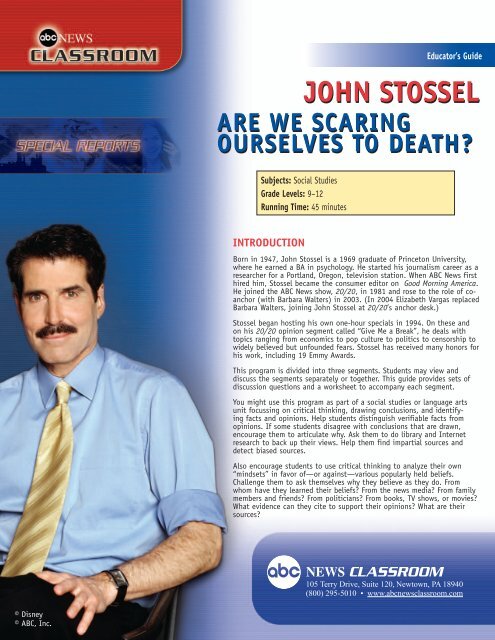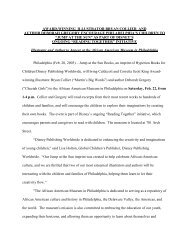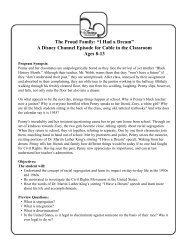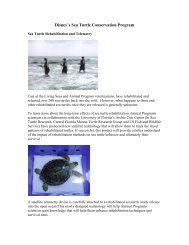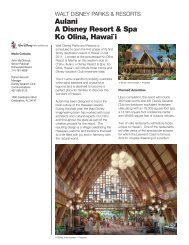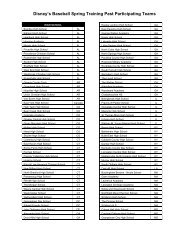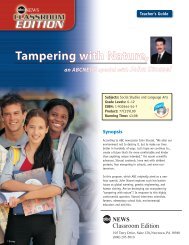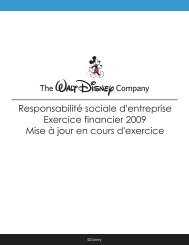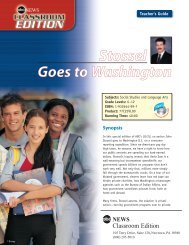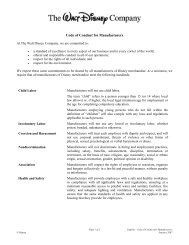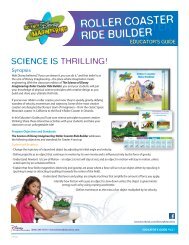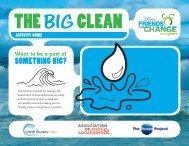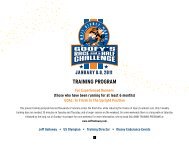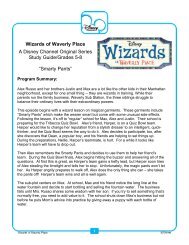john stossel are we scaring ourselves to death?
john stossel are we scaring ourselves to death?
john stossel are we scaring ourselves to death?
Create successful ePaper yourself
Turn your PDF publications into a flip-book with our unique Google optimized e-Paper software.
ENVIRONMENTAL AND OTHER RISKSDVD Chapters 5 and 6 (16:00)Use with Response Sheet #3Environmental Risks and the EPA - Chapter 5 (10:00)Concept: Democracy and riskJohn S<strong>to</strong>ssel shows the example of Aspen, Colorado, where,despite high lead levels in the soil, there was no his<strong>to</strong>ryof illness caused by lead. Although blood tests sho<strong>we</strong>dthat the lead levels of Aspen children <strong>we</strong>re among thelo<strong>we</strong>st in the nation, the EPA (Environmental ProtectionAdministration) still wanted <strong>to</strong> level houses and removefour feet of <strong>to</strong>psoil.Consider what former President Ronald Reagan said: “Thenine scariest words in the English language <strong>are</strong>: ‘We’re fromthe government and <strong>we</strong>’re here <strong>to</strong> help.’”Concept: Regulation and costsThe introduction of new drugs fell from an average of38 per year bet<strong>we</strong>en 1951-62, <strong>to</strong> fe<strong>we</strong>r than 17 per yearbet<strong>we</strong>en 1963-90. By concentrating on reducing the riskfrom bad drugs, Congress and the FDA (Food and DrugAdministration) may have contributed <strong>to</strong> the <strong>death</strong> ofthose denied access <strong>to</strong> potentially lifesaving drugs.Freedom <strong>to</strong> try things helps us determine how <strong>to</strong> make lifesafer. Should the early inven<strong>to</strong>rs of airplanes have beenprohibited from trying <strong>to</strong> fly because some who tried <strong>we</strong>rekilled? Their mistakes led <strong>to</strong> the safe air travel <strong>we</strong> enjoy<strong>to</strong>day.Discussion Questions:1. Can there be <strong>to</strong>o much government regulation?2. Should federal or state government be able <strong>to</strong> makecommunities act against their will?3. How do <strong>we</strong> judge science? Which evidence did youfind most convincing in the case of the lead in theAspen soil? Why?Freedom, Prosperity and Safety - Chapter 6 (6:00)Concept: Resource allocation and innovationIf <strong>we</strong> focus our spending on efforts <strong>to</strong> achieve safety and“risk-free” living, what will happen <strong>to</strong> progress? Progress isdependent upon innovation, and innovation is born of risk.Allowing people <strong>to</strong> risk harm or financial loss may havebad consequences for the person involved but improve thelives of many others.Concept: Personal freedom vs. safetyUnintended consequences often accompany innovation.Once government mandates a safety requirement it is verydifficult <strong>to</strong> change. Air bags <strong>are</strong> required and they do savelives. But they have also killed infants and elderly folks. Ifgovernment didn’t require airbags people would be free <strong>to</strong>choose bet<strong>we</strong>en this added protection and the added risk<strong>to</strong> children and grandp<strong>are</strong>nts.Discussion Questions:1. Should <strong>we</strong> trust scientists, government or <strong>ourselves</strong>?2. Do you agree with S<strong>to</strong>ssel’s concern that fear of riskwill slow progress?3. Which do you value more, freedom or safety?ARE WE SCARING OURSELVES TO DEATH?-5-© Disney© ABC, Inc.
RESPONSE SHEET #1(Discuss after watching Chapter 1 – Is Crime Increasing?and Chapter 2 – Why Do We Feel Crime is Increasing?)Use these questions as a starting point for discussion and further research. Also jot down any questions that come in<strong>to</strong> your mindas you view the show.1. Refute the following statement: “Risk is bad, therefore, everyone benefits by having less risk.”2. How do scarcity and opportunity costs explain why certain public policies designed <strong>to</strong> reduce risk can increase risk?3. How do insurers protect against moral hazard and adverse selection?4. Mr. S<strong>to</strong>ssel observes that gated communities reduce interaction bet<strong>we</strong>en different groups. He later suggests that lack of familiarityleads <strong>to</strong> increased fearfulness and an increased perception of risk. Do the interview segments in the video support thoseconclusions? State an example from the video.5. Without talking about money, what does it cost you <strong>to</strong> live as part of a community? What <strong>are</strong> the benefits?ARE WE SCARING OURSELVES TO DEATH?© Disney© ABC, Inc.
RESPONSE SHEET #3(Discuss after watching Chapter 5 – Environmental Risks and Safteyand Chapter 6 – Freedom, Prosperity and Safety.)Use these questions as a starting point for discussion and further research. Also jot down any questions that come in<strong>to</strong> your mindas you view the show.1. Why does the FDA keep lifesaving drugs off the market and “statistically murder” thousands of people every year?2. “Public policy should reduce pollution and other risks <strong>to</strong> zero.” What does this tell us about the concept of scarcity and unintendedconsequences?3. On average, do new technologies pose more risk or less risk? Explain.4. What effects do regulations designed <strong>to</strong> enhance workplace safety have on the incentives <strong>to</strong> create <strong>we</strong>alth and higher wages?5. Some say that Superfund has become a “lawyers’ slush fund.” What do you think, and why?ARE WE SCARING OURSELVES TO DEATH?© Disney© ABC, Inc.
FINAL RESPONSE SHEET(Discuss after watching all six chapters.)1. Define the cost/benefit principle. Give an example in terms of risk/safety.2. Why is there an increased fear of risk? What steps can be taken <strong>to</strong> properly assess risk?3. What fac<strong>to</strong>rs and/or policies <strong>are</strong> most likely <strong>to</strong> change criminal behavior?4. What issues must be considered when trying <strong>to</strong> reduce crime?5. Explain how regulations result in unintended consequences.ARE WE SCARING OURSELVES TO DEATH?© Disney© ABC, Inc.
KEY WORDS AND CONCEPTSadverse selectionriskcausationrisk aversecorrelationrisk takersDelaney Clausescarcitydiminishing marginal benefitsspurious correlationdrug lagSuperfundequilibriumtransaction costsheadline hysteriaType I errorinformation costsType II errormoral hazardunlimited desiresopportunity costvariancerational ignorancezero <strong>to</strong>leranceARE WE SCARING OURSELVES TO DEATH?-10-© Disney© ABC, Inc.
SPECIAL THANKSABCNEWS Classroom acknowledges In The Classroom Media forits development of classroom materials for this title.In The Classroom Media1502 Po<strong>we</strong>ll AvenueErie, PA 16505www.intheclassroom.orgJOHN STOSSELARE WE SCARINGOURSELVES TO DEATH?FOR MORE INFORMATIONVisit www.abcnewsclassroom.com.NEWS CLASSROOM105 Terry Drive, Suite 120, New<strong>to</strong>wn, PA 18940(800) 295-5010 • www.abcnewsclassroom.com© Disney© ABC, Inc.


